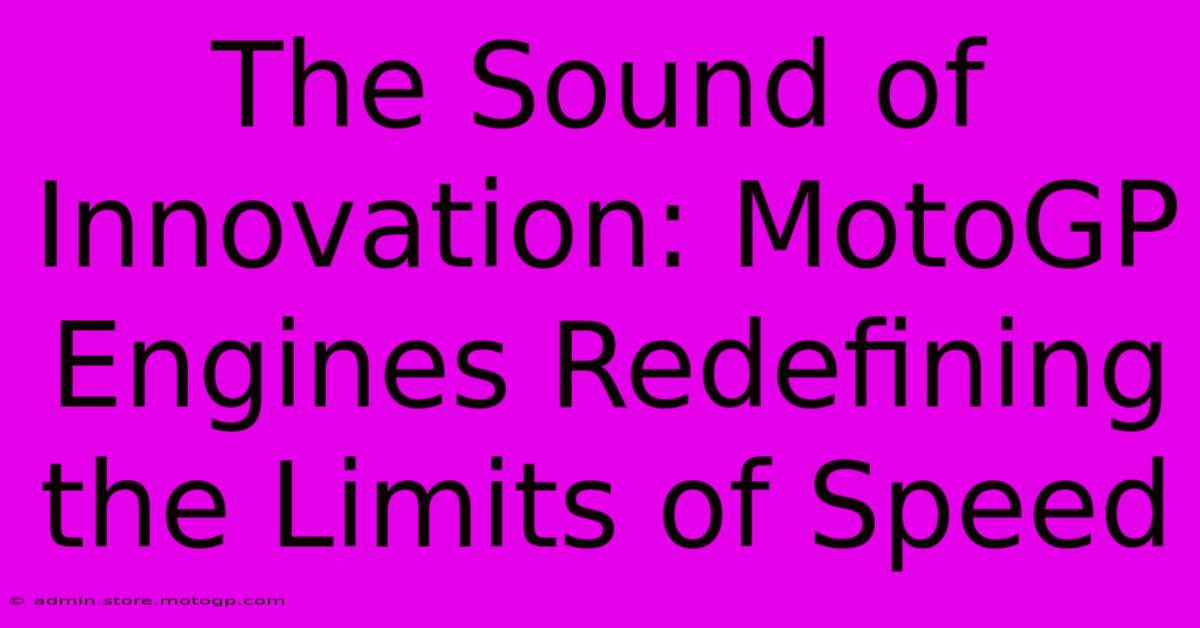The Sound Of Innovation: MotoGP Engines Redefining The Limits Of Speed

Table of Contents
The Sound of Innovation: MotoGP Engines Redefining the Limits of Speed
The roar of MotoGP engines is more than just noise; it's the symphony of cutting-edge technology pushing the boundaries of speed and engineering. Each engine represents a pinnacle of innovation, a testament to human ingenuity striving for ultimate performance. This article delves into the heart of these incredible machines, exploring the technology, the evolution, and the future of MotoGP engines.
The Heart of the Beast: Engine Specifications and Technology
MotoGP engines are complex beasts, meticulously engineered for maximum power and minimal weight. Currently, the regulations dictate prototype four-stroke 1000cc engines, a significant departure from the two-stroke screamers of the past. This shift reflects a commitment to environmental responsibility and a drive towards more sustainable racing.
Key Technological Advancements:
- Pneumatic Valves: Many teams utilize pneumatic valve actuation systems, allowing for incredibly high engine speeds and precise valve timing. This technology, borrowed from Formula 1, ensures optimal combustion and maximizes power output.
- Sophisticated Electronics: Engine management systems are incredibly advanced, constantly monitoring and adjusting parameters like fuel injection, ignition timing, and even individual cylinder performance. These systems are crucial for optimizing power delivery across the diverse track conditions encountered throughout the season.
- Lightweight Materials: The use of exotic materials like titanium and carbon fiber is paramount. Reducing weight is crucial for improving handling and acceleration, leading to faster lap times. Every gram counts in the relentless pursuit of speed.
- Seamless Shift Gears: Quick-shifters allow riders to change gears without using the clutch, enabling incredibly smooth acceleration and reducing time lost during gear changes. This technology is essential in maintaining momentum through corners and on straights.
- High-Performance Lubricants: Specialized engine oils are essential for handling the extreme conditions within the MotoGP engine. These lubricants are designed to withstand intense heat and pressure, ensuring optimal engine performance and longevity.
Evolution of MotoGP Engines: From Two-Stroke Screams to Four-Stroke Fury
The history of MotoGP engines is a fascinating journey. The ear-splitting two-stroke engines of the past, while iconic, were ultimately phased out due to environmental concerns and stricter regulations. The transition to four-stroke engines marked a significant shift, demanding a new approach to engineering and performance optimization.
The Two-Stroke Era: A Legacy of Raw Power
The screaming two-strokes, with their distinctive high-pitched roar, defined an era of MotoGP. They were incredibly powerful, but also less efficient and significantly more polluting than their four-stroke counterparts. This era left an undeniable mark on the sport, creating a legacy of legendary riders and unforgettable races.
The Four-Stroke Revolution: Efficiency and Refinement
The shift to four-stroke engines brought about a new era of sophistication. While initially lacking the raw power of their two-stroke predecessors, four-stroke engines offered improved efficiency, reduced emissions, and greater potential for technological advancements. This paved the way for the incredible engineering marvels we see on the track today.
The Future of MotoGP Engines: Sustainability and Technological Leap
The future of MotoGP engines is likely to be shaped by a relentless pursuit of higher performance alongside a growing focus on sustainability. We can expect further innovations in areas like:
- Hybrid Technology: The incorporation of hybrid systems could improve efficiency and potentially reduce emissions further.
- Biofuels: The use of sustainable biofuels could help to lessen the environmental impact of the sport.
- Advanced Materials: Ongoing research into lighter and stronger materials will continue to drive performance gains.
- Artificial Intelligence: AI-driven engine management systems could offer even finer control and optimization.
The sound of innovation in MotoGP is a powerful reminder of the relentless pursuit of perfection. The continuous evolution of these incredible machines ensures the sport remains at the forefront of technological advancement, captivating audiences with breathtaking speed and captivating engineering. The future promises even greater leaps forward, guaranteeing that the roar of MotoGP engines will continue to thrill for years to come.

Thank you for visiting our website wich cover about The Sound Of Innovation: MotoGP Engines Redefining The Limits Of Speed. We hope the information provided has been useful to you. Feel free to contact us if you have any questions or need further assistance. See you next time and dont miss to bookmark.
Featured Posts
-
F1 Austin Explore The City Beyond The Track
Feb 18, 2025
-
Experience The Adrenaline Rush Of Circuit Racing
Feb 18, 2025
-
Motorcycle Racing And Addiction Overcoming Challenges
Feb 18, 2025
-
Moto3 Bikes Pocket Rockets With Big Performance
Feb 18, 2025
-
Moto Gp Images Tech Titans Explore The Engineering Of Moto Gp Bikes
Feb 18, 2025
